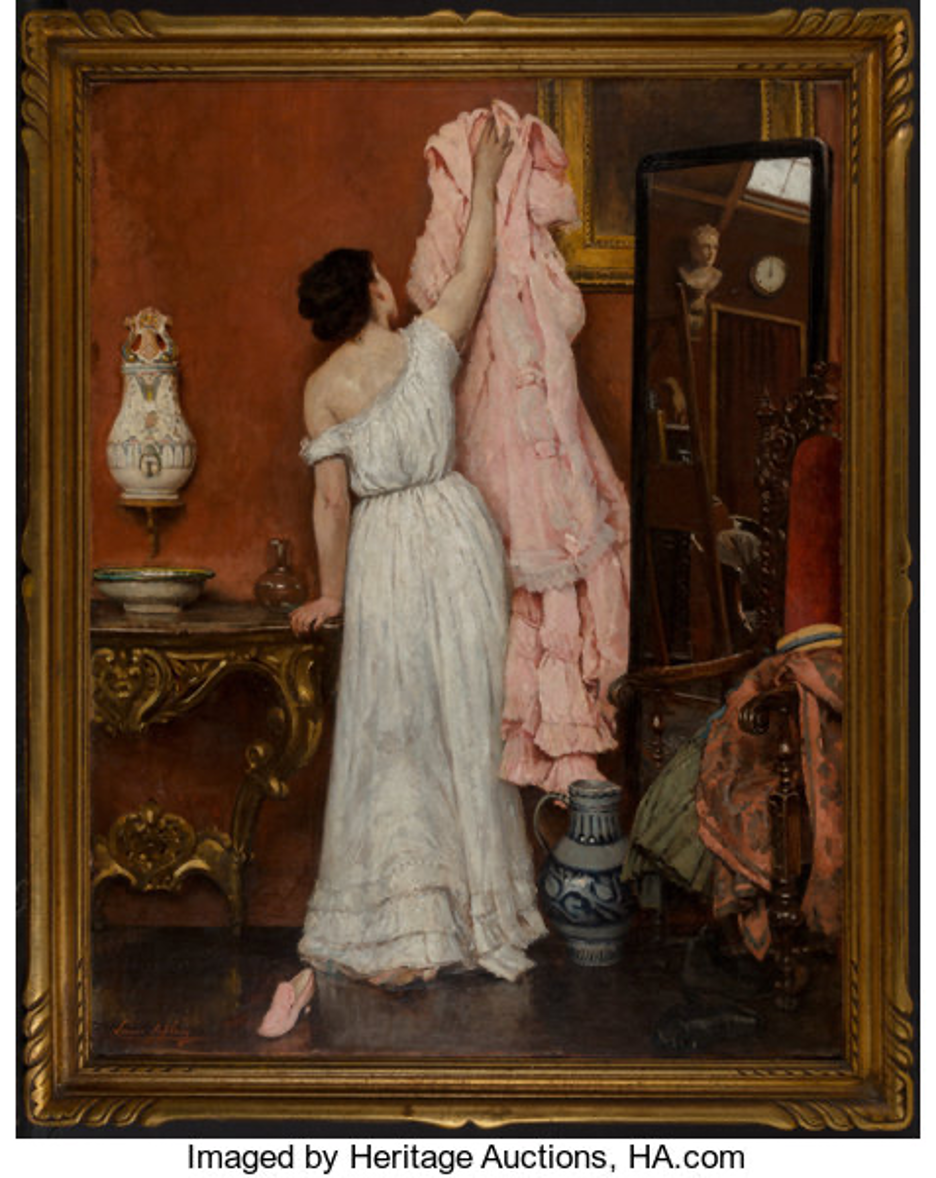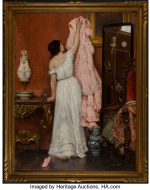Created by Emily Goldstein on Fri, 10/23/2020 - 01:25
Description:
This painting, titled “A modern Cinderella” (1875), was created with oil paints by Louise Jopling, a prominent Victorian artist who rose to fame in the 19th century after she established an all-female school for artists in London, called “Mrs. Jopling’s School of Art.” In this image, Jopling depicts a woman removing her pink, frilly dress to reveal simple underclothing, who loses her left shoe in the process. While the painting is a nod to the folk and fairy tale after which it is named, further examination reveals hidden feminist themes.
Jopling portrays three different kinds of dresses in this painting – a woman’s underclothes, an evening gown, and a day dress draped across the chair on the right side of the picture. The day dress on the chair looks to be made of heavy silk with a brocade pattern that resembles that of furniture – a style that came into fashion in the late 1870’s and early 1880’s as women opted for rich, dark colors and prominent embellishment. The underdress, which is white and fits the natural waist, was also typical of the time. The evening gown being hung on a hook in the center of the piece is highly fashionable, and most likely very expensive. In the early in 1870’s the evening gowns in vogue were most often pastel silk, with extravagant decoration of frills, lace, and bows (Shrimpton). The delicacy and lavishness of the pink dress, in combination with the multiple decorative vases, the washing station, the bust on the wall behind her, and the ornate furnishings signify that the subject of the painting is a member of the upper class. The woman depicted seems to have left an evening ball and was caught in the middle of removing her gown at the end of a long night to return to her every-day outfit, which would align with its fairy tale namesake of the painting.
The floor-length mirror, however, adds a new layer of understanding to the image. In Victorian Art, mirrors carried a significant amount of symbolism. While they would be used practically to add interest or drama to a picture, they often represented the unseen aspect of the subject’s life or personality. In this portrait, we see a clock striking midnight, which is an obvious nod to the title, but more interestingly, we see an artist’s easel resting against the back wall. In the realm portraiture, the area in which Jopling made most of her money, the artist would rarely make themselves known, and thus the inclusion of Jopling’s easel has led art historians to wonder if this is not simply portrait, but instead, a self-portrait.
If this is, indeed, a self-portrait, Jopling has painted herself as somewhere in the liminal space between the social groups she simultaneously belonged to and was excluded from. Despite Jopling’s notoriety and prominence among high-class Pre-Raphaelite artist circles, she experienced a high degree of discrimination. In 1883, she was commissioned to paint a portrait for 150 guineas but lost her employment in favor of Sir John Everett Millais, who requested 1000 guineas for the same project (Clement). In the traditional circles of high society, Jopling was looked down upon for pursuing a career in the fine arts, which was inherently a masculine task. The woman in the image is either taking the dress off or putting it on, but either way, has turned her back to her easel, which could be interpreted as forfeiting a part of her true identity to fit either end of the accepted spectrum of femininity. The underclothing she portrays herself in fit the Pre-Raphaelite aesthetic style of dress, which fit natural waists and emphasized a woman’s beauty through medieval and Greek- inspired silhouettes (Shrimpton). The inclusion of this white aesthetic dress, as well as the scandalous drop of the strap is a signal of societal rebellion against traditional beauty norms. The woman in the image could also be read as shedding the skin of the two dresses before her to reveal her true, natural, artistic self below.
“A modern Cinderella (1875)” seems to invite the viewer into the studio of an upper-class artist who is making a decision about how she wants the world to see her, hidden under the guise of a modern fairytale retelling. Jopling has never explained this painting, but instead leaves entirely up to the viewer’s interpretation – an act which, in and of itself, could be interpreted in many different ways.
WORKS CITED
Bailey, Alison. “Louise Jopling 1843-1933.” Amersham Museum, 28 May 2020, amershammuseum.org/history/people/19th-century/louise-jopling/.
Shrimpton, Jayne. Victorian Fashion. Shire Publications, 2016.
Waters, Clara Erskine Clement, and Laurence Hutton. Artists of the Nineteenth Century and Their Works a Handbook ... Houghton, Osgood & Co., 1879.
Image Citation
“A modern Cinderella, 1875. Oil on Canvas” by Louise Jopling


